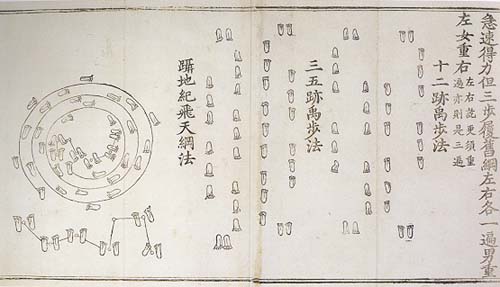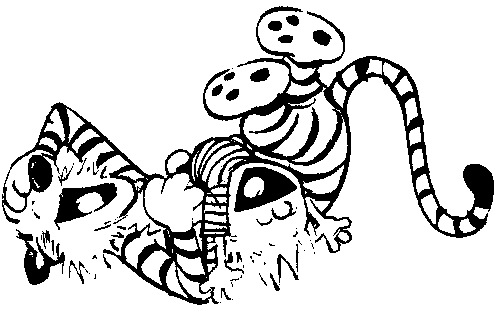The Whirling Circles of Ba Gua Zhang (last chapter)
/ The last chapter of The Whirling Circles of Ba Gua Zhang, is titled "A Moving Yi Jing." The meat and potatoes of this chapter are two great lists.
The last chapter of The Whirling Circles of Ba Gua Zhang, is titled "A Moving Yi Jing." The meat and potatoes of this chapter are two great lists.The first list is a paragraph for each of the qi transmissions associated with each of the eight "mother palms" and gua (trigrams) of B.K. Frantzis's baguazhang system (which has no form).
The qi transmissions are supplemented in the applications section too. The authors clearly and succinctly describe the feeling of each palm change; how it moves and what makes it distinct. They also explain that the best way to develop these qi transmissions is through the practice of Soft-hands, Roshou (a dynamic moving and slapping version of push-hands).
I plan to do a video for each of the Baguazhang qi transmissions with in a year.
What is a Daoist Body?Â
The second list is this:

- The Physical Body
- The Qi Body
- The Emotional Body
- The Thinking Body
- The Psychic Body
- The Causal Body
- The Body of Individuality
- The body of the Dao
The authors give very short descriptions of what each category might mean, calling them energy bodies. Beyond that what they say is embarrassing for it's lack of connection to anything real. (Baguazhang is not a self-help program, and neither is the Yijing.)
Religious Daoism conceptualizes a human being as not just one body but many bodies. Calling them "energy bodies" is misleading. Your house is a body that you share with everyone else who lives there. You can clean, remodel, or move to another house, but the fact that you have such a body is a given. All bodies relate to other bodies. If you live in a damp shack for a month your physical body will start to creek at the joints and your lung capacity will decrease (effecting your qi body).
The way religious Daoists conceptualize it, we share a body with everyone who reads this blog or speaks English. More importantly, we share a body with everyone who makes the same commitments we do, thus Christians all share a body, Muslims all share a body, and everyone who worships Guanyin shares a body.

Ghosts have very weak bodies, demons and gods very strong ones (we give them our strength).
Horror movies are so visceral because as you watch them your various "commitment bodies" are being contorted, poked and exploded. (Obviously, I love the horror genre.)
This is a list used to train Daoist exorcists. In order to do an exorcism you must be able to recognize all the different types of possession in other people and in yourself.
- Physical possession is pain. In it's lesser forms we recognize it as tension or even "strength." Physical possession causes people to lash out and to blame.
- Qi possession is associated with controlling the breath, it amplifies feelings, creates excitement and it can lead to transcendent states. (Godlike or "I can't feel my body" types of disassociation.) Mania.
- Emotional possession translates perfectly into English. Possessed by fear, anger, love, etc...
- Thinking possession is like believing that the oceans are going to rise because we drive to work. Or that everything that happens in the Middle-East matters. You know, "Global Conspiracy," "The world is in crisis, dude."
- Psychic possession is believing you know what someone else is thinking, or what is about to happen next.
- Causal possession is like schizophrenia. When you think objects or icons or voices in your head are the cause of something in the real world. Profound disassociation.
- The body of Individuation is supreme ego-mania. There are a number of narcotics that can bring about this near-death experience. It is when you feel/believe that you are the cause and purpose of everything.
- The body of the Dao is a complete death. Sometimes call immortality. It is experience without any limits or conceptions.
Baguazhang is a dance form that explores all the different ways we can become possessed. It is dancing with what it is to be alive. Perhaps we could think of it as a personal, daily exorcism, although that certianly isn't traditional.
In case I lost you-- and you don't see the connection to martial arts-- notice that I just made a really good list of what might cause someone to attack you.



 something different. Here is a fun one (#33). The Chinese title is "not-two-natural-principle" The authors' translated it "Accuracy Method.":
something different. Here is a fun one (#33). The Chinese title is "not-two-natural-principle" The authors' translated it "Accuracy Method.": Here I continue my commentary on The
Here I continue my commentary on The  Not long ago I read somewhere that Martial Artists are left handed way out of proportion to their presence in the general society. At the time my morning class was 70% lefties.
Not long ago I read somewhere that Martial Artists are left handed way out of proportion to their presence in the general society. At the time my morning class was 70% lefties. Is this because us lefties have some advantage in fighting? Or do we
Is this because us lefties have some advantage in fighting? Or do we just have more inner torment because deep down, we know we don't belong? In Italian left hand is "mano sinistra", the sinister hand.
just have more inner torment because deep down, we know we don't belong? In Italian left hand is "mano sinistra", the sinister hand. The problem is doubled for lefties with long legs. Not that I ever
The problem is doubled for lefties with long legs. Not that I ever accepted my victim hood; I refused to sit in these types of chairs in high school. If the classroom had them I brought along a foam backpackers mat and sat on it against the wall in the back of class.
accepted my victim hood; I refused to sit in these types of chairs in high school. If the classroom had them I brought along a foam backpackers mat and sat on it against the wall in the back of class. If you haven't read Yang-Chu, I recommend it. Yang-Chu is considered one of the early voices of Daoism (300 BCE), a voice for wuwei.
If you haven't read Yang-Chu, I recommend it. Yang-Chu is considered one of the early voices of Daoism (300 BCE), a voice for wuwei. first heard this I was in shock for a few days. Why was I bothering with all the little details, like doing the dishes and "communicating" if almost all the significant data was in a 15 minute video interview? Is it possible that we really don't have free will?
first heard this I was in shock for a few days. Why was I bothering with all the little details, like doing the dishes and "communicating" if almost all the significant data was in a 15 minute video interview? Is it possible that we really don't have free will?
 Chinese internal arts are very different than Yoga. The biggest difference is that Yoga breathing is in unison with the movement. In Chinese internal arts our breathing is natural. In fact, if you have taught yourself to breath in unison with the movement, you have to un-teach yourself. The stronger your yoga practice is, the more you'll feel your breathing get stuck in a pattern.
Chinese internal arts are very different than Yoga. The biggest difference is that Yoga breathing is in unison with the movement. In Chinese internal arts our breathing is natural. In fact, if you have taught yourself to breath in unison with the movement, you have to un-teach yourself. The stronger your yoga practice is, the more you'll feel your breathing get stuck in a pattern.